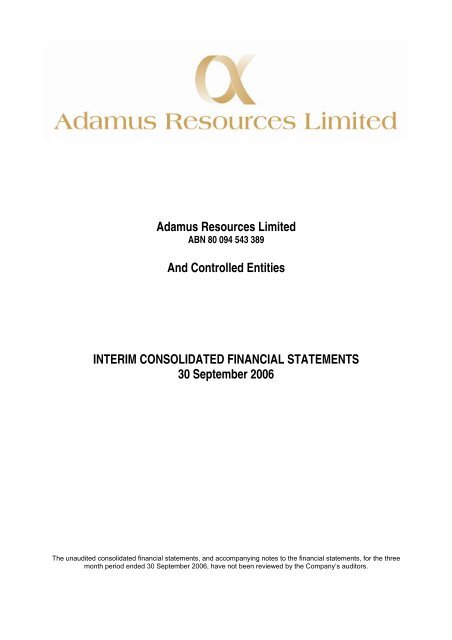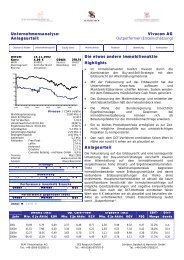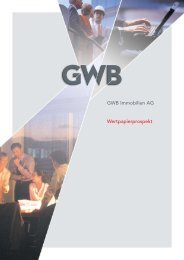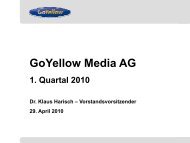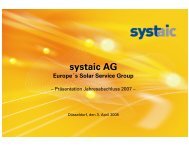Adamus Resources Limited And Controlled Entities INTERIM ...
Adamus Resources Limited And Controlled Entities INTERIM ...
Adamus Resources Limited And Controlled Entities INTERIM ...
Create successful ePaper yourself
Turn your PDF publications into a flip-book with our unique Google optimized e-Paper software.
<strong>Adamus</strong> <strong>Resources</strong> <strong>Limited</strong><br />
ABN 80 094 543 389<br />
<strong>And</strong> <strong>Controlled</strong> <strong>Entities</strong><br />
<strong>INTERIM</strong> CONSOLIDATED FINANCIAL STATEMENTS<br />
30 September 2006<br />
The unaudited consolidated financial statements, and accompanying notes to the financial statements, for the three<br />
month period ended 30 September 2006, have not been reviewed by the Company’s auditors.
<strong>Adamus</strong> <strong>Resources</strong> <strong>Limited</strong><br />
For the Three Months Ended 30 September 2006<br />
Consolidated Balance Sheet<br />
(Expressed in Australian Dollars)<br />
(Unaudited)<br />
Consolidated<br />
As at<br />
30 Sept 2006 30 June 2006<br />
$<br />
$<br />
ASSETS<br />
Current Assets<br />
Cash and cash equivalents 10,378,775 14,208,014<br />
Trade and other receivables 55,231 82,089<br />
Prepayments - 9,119<br />
Total Current Assets 10,434,006 14,299,222<br />
Non Current Assets<br />
Other receivables 23,000 23,000<br />
Property, plant & equipment 63,848 70,275<br />
Mineral exploration and evaluation 31,047,280 26,562,309<br />
Total Non Current Assets 31,134,128 26,655,584<br />
TOTAL ASSETS 41,568,134 40,954,806<br />
LIABILITIES<br />
Current Liabilities<br />
Trade and other payables 42,877 1,196,729<br />
Provisions 156,256 156,256<br />
Total Current Liabilities 199,133 1,352,985<br />
TOTAL LIABILITIES 199,133 1,352,985<br />
NET ASSETS 41,369,001 39,601,821<br />
EQUITY<br />
Contributed Equity 46,979,302 44,633,702<br />
Reserves 337,636 306,114<br />
Accumulated losses (5,947,937) (5,337,995)<br />
TOTAL EQUITY 41,369,001 39,601,821<br />
The above Consolidated Balance Sheet is to be read in conjunction with the Notes to the Financial Statements
<strong>Adamus</strong> <strong>Resources</strong> <strong>Limited</strong><br />
For the Three Months Ended 30 September 2006<br />
Consolidated Income Statement<br />
(Expressed in Australian Dollars)<br />
(Unaudited)<br />
For the Three Months Ended<br />
30 Sept 2006<br />
$<br />
30 Sept 2005<br />
$<br />
Continuing operations<br />
Revenue 92,738 58,311<br />
Employee benefits expense (142,855) (75,184)<br />
Corporate expenses (26,216) (45,232)<br />
Communications (11,438) (13,980)<br />
Premise expenses (36,478) (26,947)<br />
Administration expenses (130,482) (130,755)<br />
North American promotional expenditure (25,239) (15,123)<br />
Foreign exchange gain (loss) (300,859) (307,115)<br />
Loss from continuing operations before tax and finance costs (580,829) (556,025)<br />
Finance costs (29,113) (2,570)<br />
Loss before income tax (609,942) (558,595)<br />
Income tax - -<br />
Loss after tax from continuing operations (609,942) (558,595)<br />
Net loss attributable to members of the parent (609,942) (558,595)<br />
Earnings per share (cents per share)<br />
Basic loss for the year (0.53) (0.65)<br />
The above Consolidated Income Statement is to be read in conjunction with the Notes to the Financial Statements
<strong>Adamus</strong> <strong>Resources</strong> <strong>Limited</strong><br />
For the Three Months Ended 30 September 2006<br />
Consolidated Cash Flow Statement<br />
(Expressed in Australian Dollars)<br />
(Unaudited)<br />
For the Three Months Ended<br />
30 Sept 2006 30 Sept 2005<br />
$ $<br />
Cash flows from operating activities<br />
Payments to suppliers and employees (420,323) (368,770)<br />
Interest received 127,860 57,078<br />
Payments for exploration and evaluation (3,016,206) (886,713)<br />
Interest paid (29,111) (2,570)<br />
Net cash used in operating activities (3,337,780) (1,200,975)<br />
Cash flows from investing activities<br />
Purchase of property, plant and equipment (4,922) -<br />
Payments for investments (486,537) -<br />
Net cash used in investing activities (491,459) -<br />
Cash flows from financing activities<br />
Proceeds from issue of shares - -<br />
Cost of capital raising - -<br />
Net cash provided by financing activities - -<br />
Net increase/(decrease) in cash and cash equivalents (3,829,239) (1,200,975)<br />
Cash and cash equivalents at beginning of period 14,208,014 4,587,383<br />
Cash and cash equivalents at end of period 10,378,775 3,388,408<br />
The above Consolidated Cash Flow Statement is to be read in conjunction with the Notes to the Financial Statements
<strong>Adamus</strong> <strong>Resources</strong> <strong>Limited</strong><br />
For the Three Months Ended 30 September 2006<br />
Notes to the Interim Unaudited Consolidated Financial Statements<br />
1. Nature of Operations<br />
<strong>Adamus</strong> <strong>Resources</strong> <strong>Limited</strong> is a public company incorporated in Western Australia whose shares are publicly<br />
traded on the Australian Stock Exchange.<br />
2. Summary of Significant Accounting Policies<br />
(i) Basis of Preparation<br />
The accompanying interim consolidated financial statements for the interim periods ending 30 September 2006<br />
and 2005, are prepared in accordance with Australian Accounting Standards and are unaudited, but in the opinion<br />
of management reflect all adjustments necessary for the presentation of the Company’s financial position,<br />
operations and cash flows for the period represented. These interim consolidated financial statements should be<br />
read in conjunction with the Company’s annual financial statements, including the notes thereto, as at and for the<br />
years ended June 30, 2006.<br />
The interim consolidated financial statements have been prepared on the accruals basis and historical cost basis,<br />
except for available-for-sale investments, which have been measured at fair value. The carrying values of<br />
recognised assets and liabilities that are hedged items in fair value hedges, and are otherwise carried at cost, are<br />
adjusted to record changes in the fair values attributable to the risks that are being hedged.<br />
(ii) Significant Accounting Estimates and Assumptions<br />
The carrying amounts of certain assets and liabilities are often determined based on estimates and assumptions<br />
of future events. The key estimate and assumptions that have a significant risk of causing a material adjustment<br />
to the carrying amounts of certain assets and liabilities within the next annual reporting period are:<br />
Share based payment transactions<br />
The Group measures the cost of equity-settled transactions with employees by reference to the fair value of the<br />
equity instruments at the date at which they are granted. The fair value is determined by management using a<br />
Black-Scholes option pricing model.<br />
The Group measures the cost of cash-settled share-based payments at fair value at the grant date using the<br />
Black-Scholes formula taking into account the terms and conditions upon which the instruments were granted.<br />
Mineral Exploration and Evaluation<br />
Acquisition, exploration, evaluation and development expenditure incurred is accumulated in respect of each<br />
identifiable area of interest. These costs are carried forward in respect of an area that has not at balance date<br />
reached a stage which permits a reasonable assessment of the existence or otherwise of economically<br />
recoverable reserves, and active and significant operations in, or relating to, the area of interest are continuing.<br />
(iii) Interest in joint venture operation<br />
The Group’s interest in joint venture operations is accounted for by recognising the Group’s assets and liabilities<br />
from the joint venture, as well as expenses incurred by the Group and the Group’s share of income earned from<br />
the joint venture, in the consolidated financial statements.<br />
(iv) Property, plant and equipment<br />
Plant and equipment is stated at cost less accumulated depreciation and any impairment in value.<br />
Depreciation is calculated on a straight-line basis over the estimated useful life of the asset as follows:<br />
� Computer equipment – 3 years<br />
� Plant and equipment and furniture fittings – 3-4 years<br />
� Leased assets – 3 years<br />
� Plant and equipment – over 5 to 15 years
<strong>Adamus</strong> <strong>Resources</strong> <strong>Limited</strong><br />
For the Three Months Ended 30 September 2006<br />
Notes to the Financial Statements (continued)<br />
2. Summary of Significant Accounting Policies (cont’d)<br />
(iv) Property, Plant and Equipment (cont’d)<br />
Impairment<br />
The carrying values of plant and equipment are reviewed for impairment when events or changes in<br />
circumstances indicate the carrying value may not be recoverable.<br />
For an asset that does not generate largely independent cash inflows, the recoverable amount is determined for<br />
the cash-generating unit to which the asset belongs.<br />
If any such indication exists and where the carrying values exceed the estimated recoverable amount, the<br />
assets or cash-generating units are written down to their recoverable amount.<br />
The recoverable amount of plant and equipment is the greater of fair value less costs to sell and value in use. In<br />
assessing value in use, the estimated future cash flows are discounted to their present value using a pre-tax<br />
discount rate that reflects current market assessments of the item value of money and the risks specific to the<br />
asset.<br />
An item of property, plant and equipment is derecognised upon disposal or when no future economic benefits<br />
are expected to arise from the continued use of the asset.<br />
Any gain or loss arising on derecognition of the asset (calculated as the difference between the net disposal<br />
proceeds and the carrying amount of the item) is include in the income statement in the period the item is being<br />
derecognised.<br />
(v) Mineral Exploration and Development Costs<br />
Areas in Exploration and Evaluation<br />
Exploration and evaluation costs related to an area of interest are carried forward only when rights of tenure to the<br />
area of interest are current and provided that one of the following conditions is met:<br />
� such costs are expected to be recouped through successful development and exploitation of the area of<br />
interest, or alternatively by its sale; or<br />
� exploration and/or evaluation activities in the area of interest have not yet reached a state which permits a<br />
reasonable assessment of the existence or otherwise of economically recoverable reserves, and active<br />
and significant operations in, or in relation to, the area are continuing.<br />
Costs carried forward in respect of an area of interest that is abandoned are written off in the year in which the<br />
decision to abandon is made.<br />
(vi) Foreign currency translation<br />
Both the functional and presentation currency of <strong>Adamus</strong> <strong>Resources</strong> <strong>Limited</strong> is Australian dollars (A$).<br />
Transactions in foreign currencies are initially recorded in the functional currency at the exchange rates ruling at<br />
the date of the transaction. Monetary assets and liabilities denominated in foreign currencies are retranslated at<br />
the rate of exchange ruling at the balance sheet date.<br />
All differences in the consolidated financial report are taken to the income statement with the exception of<br />
differences on foreign currency borrowings that provide a hedge against a net investment in a foreign entity.<br />
These are taken directly to equity until the disposal of the net investment, at which time they are recognised in the<br />
income statement.<br />
Tax charges and credits attributable to exchange differences on those borrowings are also recognised in equity.<br />
Non-monetary items that are measured in terms of historical cost in a foreign currency are translated using the<br />
exchange rate as at the date of the initial transaction.<br />
Non-monetary items measured at fair value in a foreign currency are translated using the exchange rates at the<br />
date when the fair value was determined.<br />
The functional currency of the overseas subsidiaries is United States dollars (US$).
<strong>Adamus</strong> <strong>Resources</strong> <strong>Limited</strong><br />
For the Three Months Ended 30 September 2006<br />
Notes to the Financial Statements (continued)<br />
2. Summary of Significant Accounting Policies (cont’d)<br />
(vi) Foreign Currency Translation (cont’d)<br />
As at the reporting date the assets and liabilities of these overseas subsidiaries are translated into the<br />
presentation currency of <strong>Adamus</strong> <strong>Resources</strong> <strong>Limited</strong> at the rate of exchange ruling at the balance sheet date<br />
and the income statements are translated at the weighted average exchange rates for the period.<br />
The exchange differences arising on the retranslation are taken directly to a separate component of equity.<br />
On disposal of a foreign entity, the deferred cumulative amount recognised in equity relating to that particular<br />
foreign operation is recognised in the income statement.<br />
(vii) Borrowing costs<br />
Borrowing costs are recognised as an expense when incurred.<br />
(viii) Goodwill<br />
Goodwill on acquisition is initially measured at cost being the excess of the cost of the business combination over<br />
the acquirer’s interest in the net fair value of the identifiable assets, liabilities and contingent liabilities.<br />
Following initial recognition, goodwill is measured at cost less any accumulated impairment losses.<br />
Goodwill is not amortised.<br />
Goodwill is reviewed for impairment, annually or more frequently if events or changes in circumstances indicated<br />
that the carrying value may be impaired.<br />
As at the acquisition date, any goodwill acquired is allocated to each of the cash-generating units expected to<br />
benefit from the combination’s synergies.<br />
Impairment is determined by assessing the recoverable amount of the cash-generating unit to which the goodwill<br />
relates. Where the recoverable amount of the cash-generating unit is less than the carrying amount, an<br />
impairment loss is recognised.<br />
Where goodwill forms part of a cash-generating unit and part of the operation within that unit is disposed of, the<br />
goodwill associated with the operation disposed of is included in the carrying amount of the operation when<br />
determining the gain or loss on disposal of the operation.<br />
Goodwill disposed of in this circumstance is measured on the basis of the relative values of the operation<br />
disposed of and the portion of the cash-generating unit retained.<br />
(ix) Recoverable amount of assets<br />
At each reporting date, the Group assesses whether there is any indication that an asset may be impaired. Where<br />
an indicator of impairment exists, the Group makes a formal estimate of recoverable amount. Where the carrying<br />
amount of an asset exceeds its recoverable amount the asset is considered impaired and is written down to its<br />
recoverable amount.<br />
Recoverable amount is the greater of fair value less costs to sell and value in use. It is determined for an<br />
individual asset, unless that asset’s value in use cannot be estimated to be close to its fair value less costs to sell<br />
and it does not generate cash inflows that are largely independent of those from other assets or groups of assets,<br />
in which case, the recoverable amount is determined fro the cash-generating unit to which the asset belongs.<br />
In assessing value in use, the estimated future cash flows are discounted to their present value using a pre-tax<br />
discount rate that reflects current market assessments of the time value of money and the risks specific to the<br />
asset.<br />
(x) Investments<br />
All investments are initially recognised at cost, being the fair value of the consideration given and including<br />
acquisition charges associated with the investment.
<strong>Adamus</strong> <strong>Resources</strong> <strong>Limited</strong><br />
For the Three Months Ended 30 September 2006<br />
Notes to the Financial Statements (continued)<br />
2. Summary of Significant Accounting Policies (cont’d)<br />
(x) Investments (cont’d)<br />
After initial recognition, investments, which are classified as held for trading and available-for-sale, are measured<br />
at fair value. Gains or losses on investments held for trading are recognised in the income statement.<br />
Gains or losses on available-for-sale investments are recognised as a separate component of equity until the<br />
investment is sold, collected or otherwise disposed of, or until the investment is determined to be impaired, at<br />
which time the cumulative gain or loss previously reported in equity is included in the income statement.<br />
Non-derivative financial assets with fixed or determinable payments and fixed maturity are classified as held-tomaturity<br />
when the Group has the positive intention and ability to hold to maturity. Investments intended to be held<br />
for an undefined period are not include in this classification.<br />
Other long-term investments that are intended to be held-to-maturity, such as bonds, are subsequently measured<br />
at amortised cost using the effective interest method.<br />
Amortised cost is calculated by taking into account any discount or premium on acquisition, over the period to<br />
maturity.<br />
For investments carried at amortised cost, gains and losses are recognised in income when the investments are<br />
derecognised or impaired, as well as thorough the amortisation process.<br />
For investments that are actively traded in organised financial markets, fair value is determined by reference to<br />
Stock Exchange quoted market bid prices at the close of business on the balance sheet date.<br />
For investments where there is no quoted market price, fair value is determined by reference to the current<br />
market value of another instrument which is substantially the same or is calculated based on the expected cash<br />
flows of the underlying net asset base of the investment.<br />
Purchases and sales of financial assets that require delivery of assets within the time frame generally established<br />
by regulation or convention in the market place are recognised on the trade date i.e. the date that the Group<br />
commits to purchase the asset.<br />
(xi) Trade and other receivables<br />
Trade receivables, which generally have 30-90 day terms, are recognised and carried at original invoice amount<br />
less an allowance for any uncollectible amounts.<br />
An estimate for doubtful debts is made when collection of the full amount is no longer a probable. Bad debts are<br />
written off when identified.<br />
(xii) Cash and cash equivalents<br />
Cash and short-term deposits in the balance sheet comprise cash at bank and in hand and short-term deposits<br />
with an original maturity of three moths or less.<br />
For the purposes of the Cash Flow Statement, cash and cash equivalents consist of cash and cash equivalents<br />
as defined above, net of outstanding bank overdrafts.<br />
(xiii) Interest-bearing loans and borrowings<br />
All loans and borrowings are initially recognised at cost, being the fair value of the consideration received net of<br />
issue costs associated with the borrowing.<br />
After initial recognition, interest-bearing loans and borrowings are subsequently measured at amortised cost using<br />
the effective interest method. Amortised cost is calculated by taking into account any issue costs, and any<br />
discount or premium settlement.<br />
Gains and losses are recognised in the income statement when the liabilities are derecognised and as well as<br />
through the amortisation process.
<strong>Adamus</strong> <strong>Resources</strong> <strong>Limited</strong><br />
For the Three Months Ended 30 September 2006<br />
Notes to the Financial Statements (continued)<br />
2. Summary of Significant Accounting Policies (cont’d)<br />
(xiv) Provisions<br />
Provisions are recognised when the Group has a present obligation (legal or constructive) as a result of a past<br />
event, it is probable that an outflow of resources embodying economic benefits will be required to settle the<br />
obligation and a reliable estimate can be made of the amount of the obligation.<br />
Where the Group expects some or all of a provision to be reimbursed, for example under an insurance contract,<br />
the reimbursement is recognised as a separate asset but only when the reimbursement is virtually certain. The<br />
expense relating to any provision is presented in the income statement net of any reimbursement.<br />
If the effect of the time value of money is material, provisions are determined by discounting the expected future<br />
cash flows at a pre-tax rate that reflects current market assessments of the time value of money and, where<br />
appropriate, the risks specific to the liability.<br />
Where discounting is used, the increase in the provision due to the passage of time is recognised as a finance<br />
cost.<br />
(xv) Share-based payment transactions<br />
The Group provides benefits to employees (including directors) of the Group in the form of share-based payment<br />
transactions, whereby employees render services in exchange for shares or rights over shares (‘equity-settled<br />
transactions’).<br />
This is the following in place to provide this benefit:<br />
� the Employee Share Option Plan (ESOP), which provides benefits to directors and senior executives<br />
The cost of these equity-settled transactions with employees is measured by reference to the fair value at the<br />
date at which they are granted. The fair value is determined by management using a binomial model.<br />
In valuing equity-settled transactions, no account is taken of any performance conditions, other than conditions<br />
linked to the price of the shares of <strong>Adamus</strong> <strong>Resources</strong> <strong>Limited</strong> (‘market conditions’).<br />
The cost of equity-settled transactions is recognised, together with a corresponding increase in equity, over the<br />
period in which the performance conditions are fulfilled, ending on the date on which the relevant employees<br />
become fully entitled to the award (‘vesting date’).<br />
The cumulative expense recognised for equity-settled transactions at each reporting date until vesting date<br />
reflects (i) the extend to which the vesting period has expired and (ii) the number of awards that, in the opinion of<br />
the directors of the Group, will ultimately vest. This opinion is formed based on the best available information at<br />
balance date. No adjustments is made for the likelihood of market performance conditions being met as the effect<br />
of these conditions in included in the determination of fair value at grant date.<br />
No expense is recognised for awards that do not ultimately vest, except for awards where vesting is conditional<br />
upon a market condition.<br />
Where the terms of an equity-settled award are modified, as a minimum an expense is recognised as if the terms<br />
had not been modified. In addition, an expense is recognised for any increase in the value of the transaction as a<br />
result of the modification, as measured at the date of modification.<br />
Where an equity-settled award is cancelled, it is treated as if it had vested on the date of cancellation, and any<br />
expense not yet recognised for the award is recognised immediately. However, if a new award is substituted for<br />
the cancelled award, and designated as a replacement award on the date that it is granted, the cancelled and<br />
new award are treated as if they were a modification of the original award, as described in the previous<br />
paragraph.<br />
The dilutive effect, if any, of outstanding options is reflected as additional share dilution in the computation of<br />
earnings per share.
<strong>Adamus</strong> <strong>Resources</strong> <strong>Limited</strong><br />
For the Three Months Ended 30 September 2006<br />
Notes to the Financial Statements (continued)<br />
2. Summary of Significant Accounting Policies (cont’d)<br />
(xvi) Leases<br />
Finance leases, which transfer to the Group substantially all the risks and benefits incidental to ownership of the<br />
leased item, are capitalised at the inception of the lease at the fair value of the leased property or, if lower, at the<br />
present value of the minimum lease payments.<br />
Lease payments are apportioned between the finance charges and reduction of the lease liability so as to achieve<br />
a constant rate of interest on the remaining balance of the liability. Finance charges are charged directly against<br />
income.<br />
Capitalised leased assets are depreciated over the shorter of the estimated useful life of the asset or the lease<br />
term.<br />
Leases where the lessor retains substantially all the risks and benefits of ownership of the asset are classified as<br />
operating leases. Initial direct costs incurred in negotiating an operating lease are added to the carrying amount of<br />
the leased asset and recognised over the lease term on the same bases as the lease income.<br />
Operating lease payments are recognised as an expense in the income statement on a straight-line basis over<br />
the lease term.<br />
(xvii) Revenue<br />
Revenue is recognised to the extent that it is probable that the economic benefits will flow to the Group and the<br />
revenue can be reliably measured. The following specific recognition criteria must also be met before revenue is<br />
recognised:<br />
Interest<br />
Revenue is recognised as the interest accrues (using the effective interest method, which is the rate that exactly<br />
discounts estimated future cash receipts through the expected life of the financial instrument) to the net carrying<br />
amount of the financial asset.<br />
(xviii) Income Tax<br />
Deferred income tax is provided on all temporary differences at the balance sheet date between the tax bases of<br />
assets and liabilities and their carrying amounts for financial reporting purposes.<br />
Deferred income tax liabilities are recognised for all taxable temporary differences:<br />
� except where the deferred income tax liability arises from the initial recognition of an asset or liability in a<br />
transaction that is not a business combination and, at the time of the transaction, affects neither the<br />
accounting profit nor taxable profit or loss; or<br />
� in respect of taxable temporary differences associated with investments in subsidiaries, associates and<br />
interests in joint ventures, except where the timing of the reversal of the temporary differences can be<br />
controlled and it is probable that the temporary differences will not reverse in the foreseeable future.<br />
Deferred income tax assets are recognised for all deductible temporary differences, carry-forward of unused tax<br />
assets and unused tax losses, to the extent that it is probable that taxable profit will be available against which the<br />
deductible temporary differences, and the carry-forward of unused tax assets and unused tax losses can be<br />
utilised:<br />
� except where the deferred income tax asset relating to the deductible temporary difference arises from the<br />
initial recognition of an asset or liability in a transaction that is not a business combination and, at the time<br />
of the transaction, affects neither the accounting profit nor profit or loss; and<br />
� in respect of deductible temporary differences associated with investments in subsidiaries, associates and<br />
interests in joint ventures, deferred tax assets are only recognised to the extent that it is probable that the<br />
temporary differences will reverse in the foreseeable future and taxable profit will be available against<br />
which the temporary differences can be utilised.<br />
The carrying amount of deferred income tax assets is reviewed at year end and reduced to the extent that it is no<br />
longer probable that sufficient taxable profit will be available to allow all or part of the deferred income tax asset to<br />
be utilised.
<strong>Adamus</strong> <strong>Resources</strong> <strong>Limited</strong><br />
For the Three Months Ended 30 September 2006<br />
Notes to the Financial Statements (continued)<br />
2. Summary of Significant Accounting Policies (cont’d)<br />
(xviii) Income Tax (cont’d)<br />
Deferred income tax assets and liabilities are measured at the tax rates that are expected to apply to the year<br />
when the asset is realised or the liability is settled, based on tax rates (and tax laws) that have been enacted or<br />
substantively enacted at the balance sheet date.<br />
Income taxes relating to items recognised directly in equity are recognised in equity and not in the income<br />
statement.<br />
(xix) Other taxes<br />
Revenues, expenses and assets are recognised net of the amount of GST except:<br />
� where the GST incurred on a purchase of goods and services is not recoverable from the taxation<br />
authority, in which case the GST is recognised as part of the cost acquisition of the asset or as part of the<br />
expense item as applicable; and<br />
� receivables and payables are stated with the amount of GST included.<br />
The net amount of GST recoverable from, or payable to, the taxation authority is included as part of receivables or<br />
payables in the balance sheet.<br />
Cash flows are included in the Cash Flow Statement on a gross basis and the GST component of cash flows<br />
arising from investing and financing activities, which is recoverable from, or payable to, the taxation authority are<br />
classified as operating cash flows.<br />
Commitments and contingencies are disclosed net of the amount of GST recoverable from, or payable to, the<br />
taxation authority.<br />
3. Contributed Equity and Reserves<br />
a) Issued Capital<br />
No. of<br />
Shares<br />
Amount<br />
$<br />
Balance as at June 30, 2006<br />
Issued for other consideration<br />
112,602,376 44,633,702<br />
1<br />
Shares issued as part consideration for the acquisition of Nkroful Mining Ltd 3,665,000 2,345,600<br />
Balance as at 30 September 2006 116,267,376 46,979,302<br />
1 On 24 July 2006, the economic entity announced completion of the acquisition of Nkroful Mining <strong>Limited</strong>, which<br />
owns the Anwia South project. Upon completion, <strong>Adamus</strong> paid the final cash consideration instalment of<br />
US$365,000 and issued consideration shares totalling 3,665,000.<br />
b) Options<br />
During the quarter ended 30 September 2006, there were no options exercised or granted.<br />
During the quarter ended 30 September 2006, 324,000 options exercisable at $0.80 each on or before 16<br />
September 2006 expired.<br />
Outstanding options at 30 September 2006 are as follows:<br />
- 1,100,000 options exercisable at $0.70 cents each on or before 31 October 2008.<br />
- 550,000 options exercisable at $0.64 cents each on or before 30 November 2007.<br />
- 550,000 options exercisable at $0.86 cents each on or before 31 January 2009.
<strong>Adamus</strong> <strong>Resources</strong> <strong>Limited</strong><br />
For the Three Months Ended 30 September 2006<br />
Notes to the Financial Statements (continued)<br />
3. Contributed Equity and Reserves (cont’d)<br />
c) Share Based Payment Plan<br />
At 30 September 2006, the Company had share options outstanding for the purchase of 2,200,000 shares, of<br />
which 1,200,000 were exercisable (vested).<br />
Number<br />
WAEP $<br />
Outstanding at 30 June 2006 2,200,000 0.73<br />
Granted during the year - -<br />
Exercised during the year -<br />
-<br />
Outstanding at 30 September 2006 2,200,000 0.73<br />
During the period ended 30 September 2006, the Company recorded a stock-based compensation expense of<br />
$19,018, included in employee benefits expense, based on the fair value of options vested during the period. The<br />
stock-based compensation expense was calculated using the Black-Scholes Option Pricing Model.<br />
There were no stock options granted during the period ended 30 September 2006.<br />
The weighted average remaining contractual life for the share options outstanding as at 30 September 2006 is<br />
between 1 and 3 years.<br />
The range of exercise prices for options outstanding at 30 September 2006 was $0.64 – $0.86.<br />
The fair value of the equity-settled share options granted under the option plan is estimated as at the date of grant<br />
using a Black-Scholes options pricing model taking into account the terms and conditions upon which the options<br />
were granted.<br />
The following table lists the inputs to the model used for at 30 September 2006:<br />
2006 2005<br />
Dividend yield (%) 0 0<br />
Expected volatility (%) 65 65<br />
Risk-free interest rate (%) 5.4 5.0<br />
Expected life of options (years) 1 to 3 1 to 3<br />
The expected life of the options is based on historical data and is not necessarily indicative of exercise patterns<br />
that may occur. The expected volatility reflects the assumption that the historical volatility is indicative of future<br />
trends, which may also not necessarily be the actual outcome. No other features of options granted were<br />
incorporated into the measurement of fair value.<br />
The fair value of the cash-settled options is measured at the grant date using the Black-Scholes options pricing<br />
model taking into account the terms and conditions upon which the instruments were granted. The services<br />
received and a liability to pay for those services are recognised over the expected vesting period. Until the liability<br />
is settled it is remeasured at each reporting date with changes in fair value recognised in profit or loss.<br />
d) Reserves<br />
2006 2005<br />
$ $<br />
Foreign currency translation reserve (7,213) -<br />
Share-based payments reserve 344,849 -<br />
337,636 -
<strong>Adamus</strong> <strong>Resources</strong> <strong>Limited</strong><br />
For the Three Months Ended 30 September 2006<br />
Notes to the Financial Statements (continued)<br />
4. Commitments and Contingencies<br />
a) Property lease<br />
The Company has a lease commitment for its office premises which expires 30 September 2009. The cost of the<br />
entire premises is shared amongst sever companies in proportion to the area occupied. The Company’s<br />
proportionate share of annual rental payments under this arrangement is approximately $55,842.<br />
b) Contingent Liabilities<br />
The economic entity is not aware of any contingent liabilities which existed as at the end of the financial year or<br />
have arisen as at the date of this report.<br />
5. Segment Information<br />
Primary reporting - Geographical segments<br />
The company’s principal operating segment is in the mineral exploration industry with assets by geographical<br />
segment as follows:<br />
Segment Assets and Liabilities<br />
Assets<br />
2006<br />
$<br />
Exploration - Australia 11,521,087<br />
Exploration - Africa 30,047,047<br />
Total of all segments 41,568,134<br />
6. Earnings Per Share<br />
30 September<br />
2006<br />
$<br />
30 September<br />
2005<br />
$<br />
Loss used in the calculation of basic and dilutive earnings per share (609,942) (558,595)<br />
Weighted average number of ordinary shares outstanding during the year used in<br />
the calculation of basic earnings per share<br />
Basic loss per share<br />
Number<br />
115,341,057<br />
Cents per share<br />
(0.53)<br />
Number<br />
86,377,376<br />
Cents per share<br />
(0.65)<br />
Weighted average number of ordinary shares used in the calculation of basis loss per share is 115,341,057.<br />
Outstanding options not exercised at 30 September 2006 have not been included in the determination of basic<br />
loss per share.<br />
7. Reconciliation Of Cash<br />
For the purposes of the Condensed Cash Flow Statement, cash and cash equivalents comprise the following:<br />
30 September<br />
2006<br />
$<br />
30 June<br />
2006<br />
$<br />
Cash at bank and in hand 221,721 380,144<br />
Short-term deposits 10,157,054 13,827,870<br />
Cash at bank and in hand 10,378,775 14,208,014


